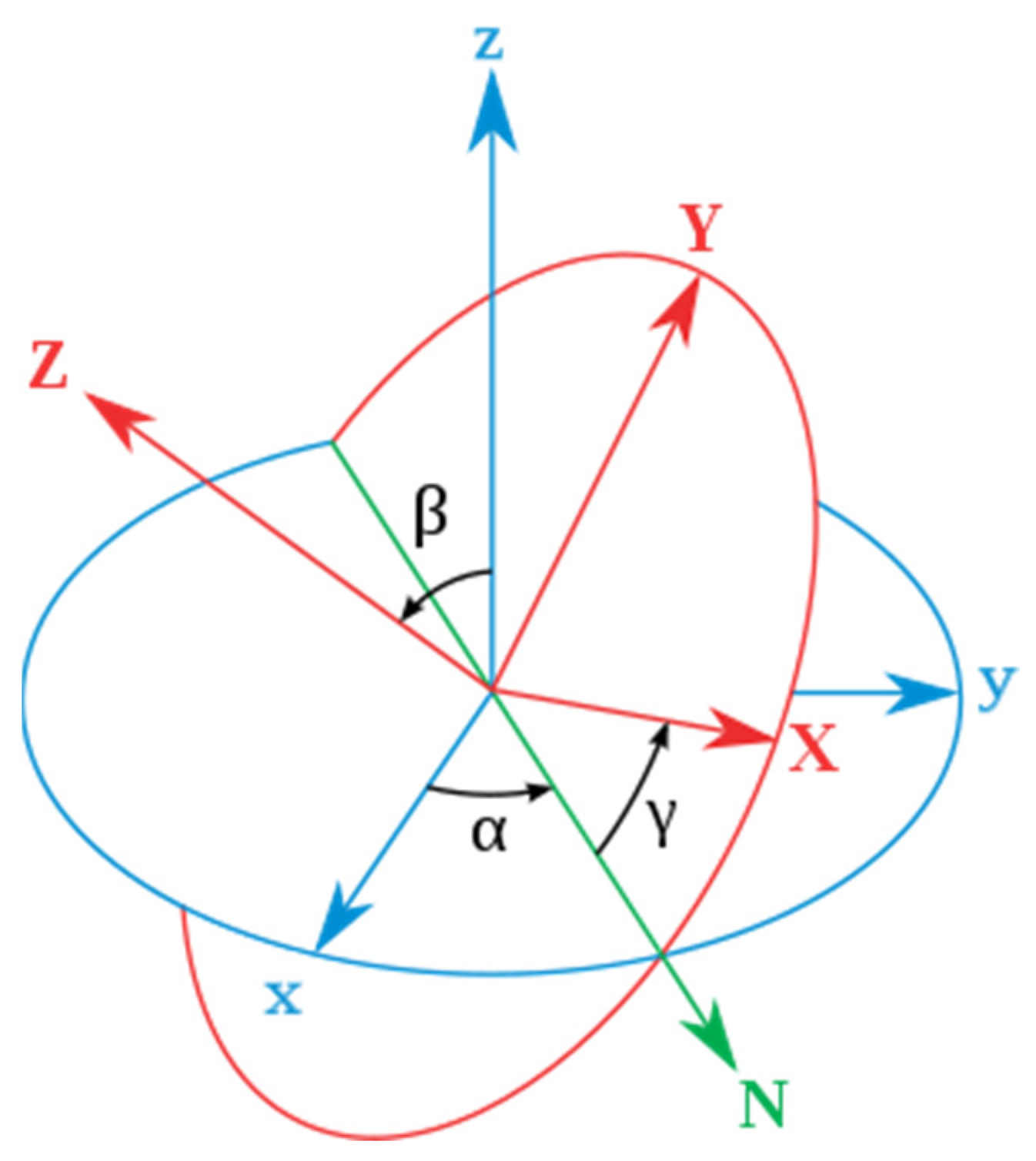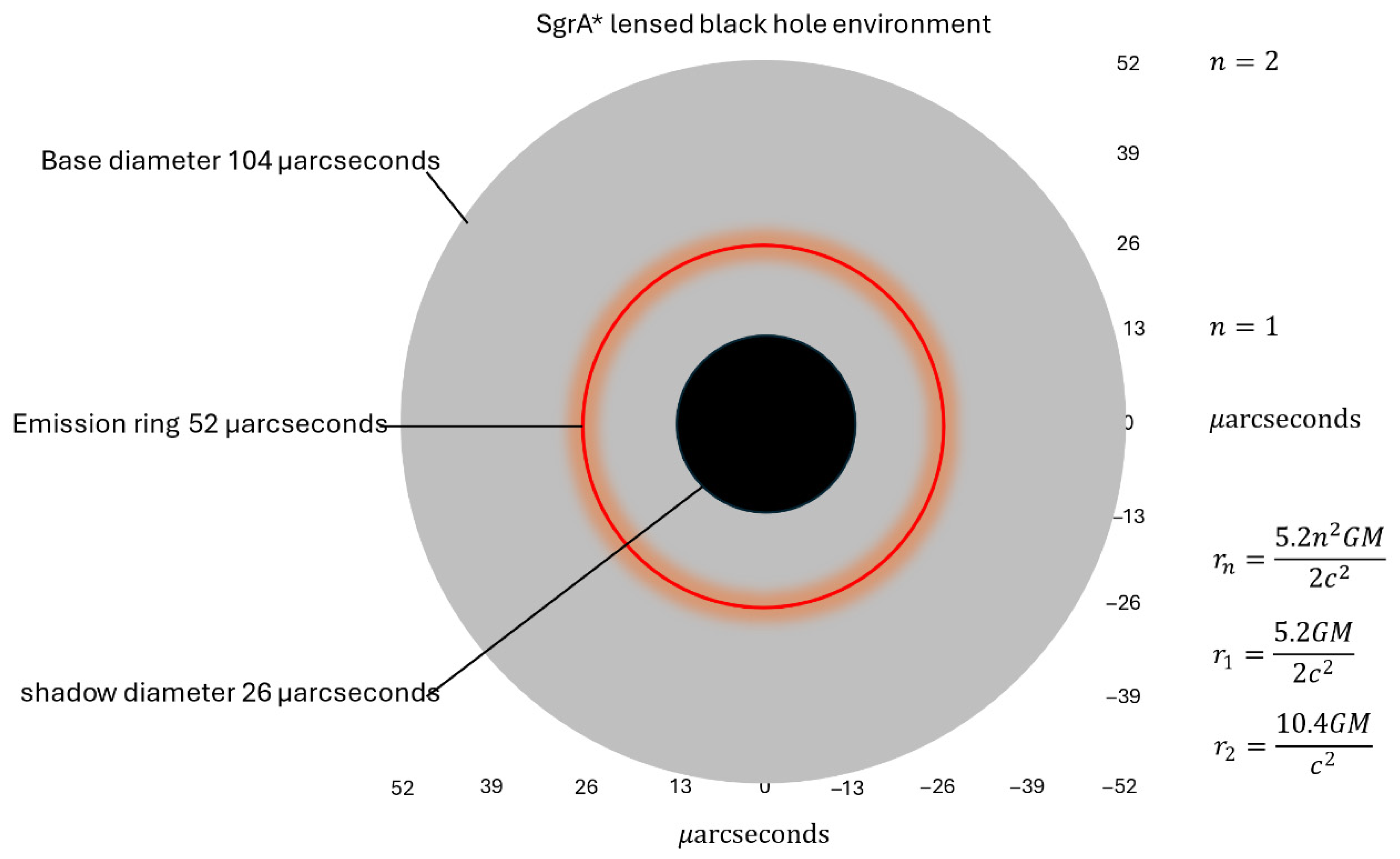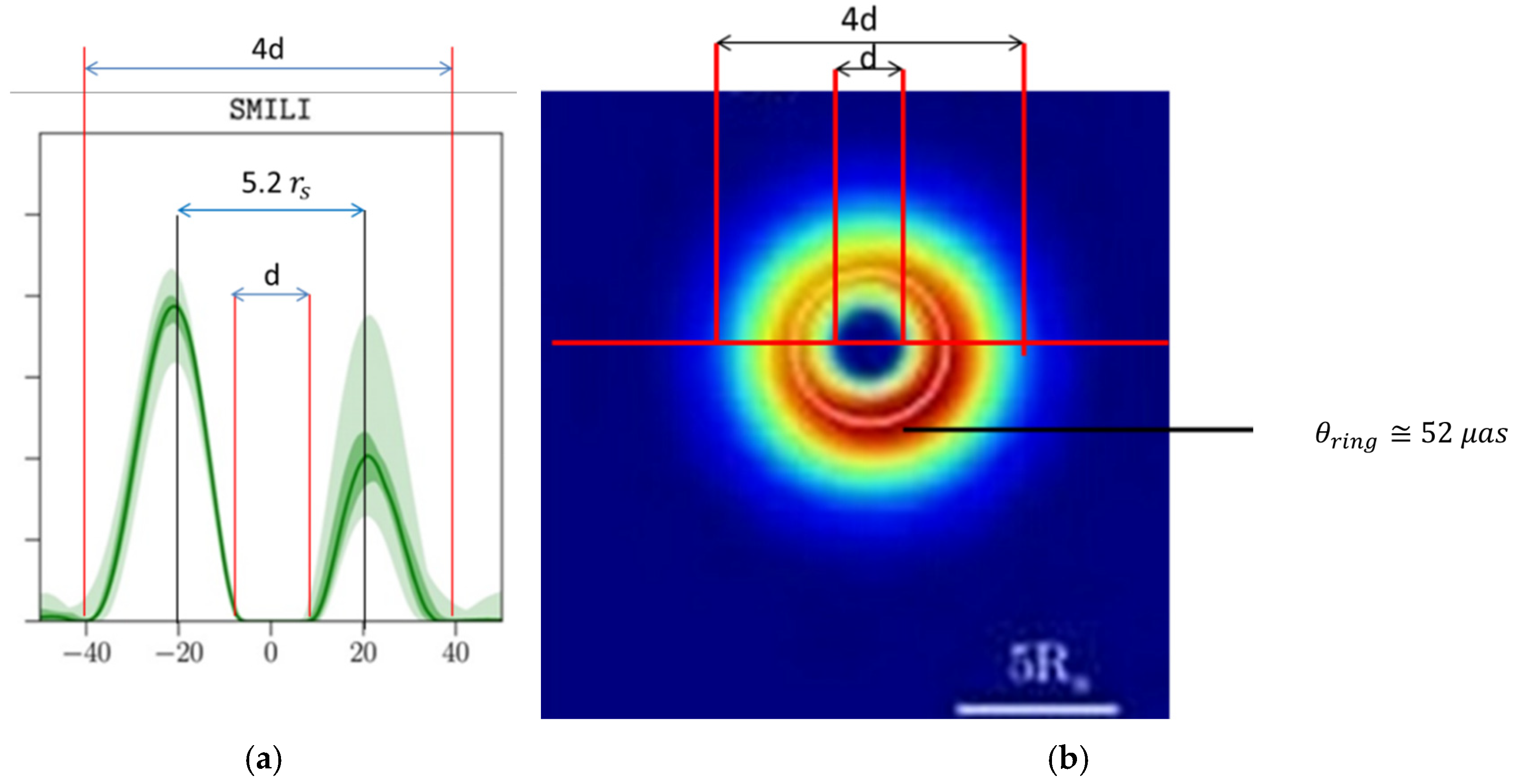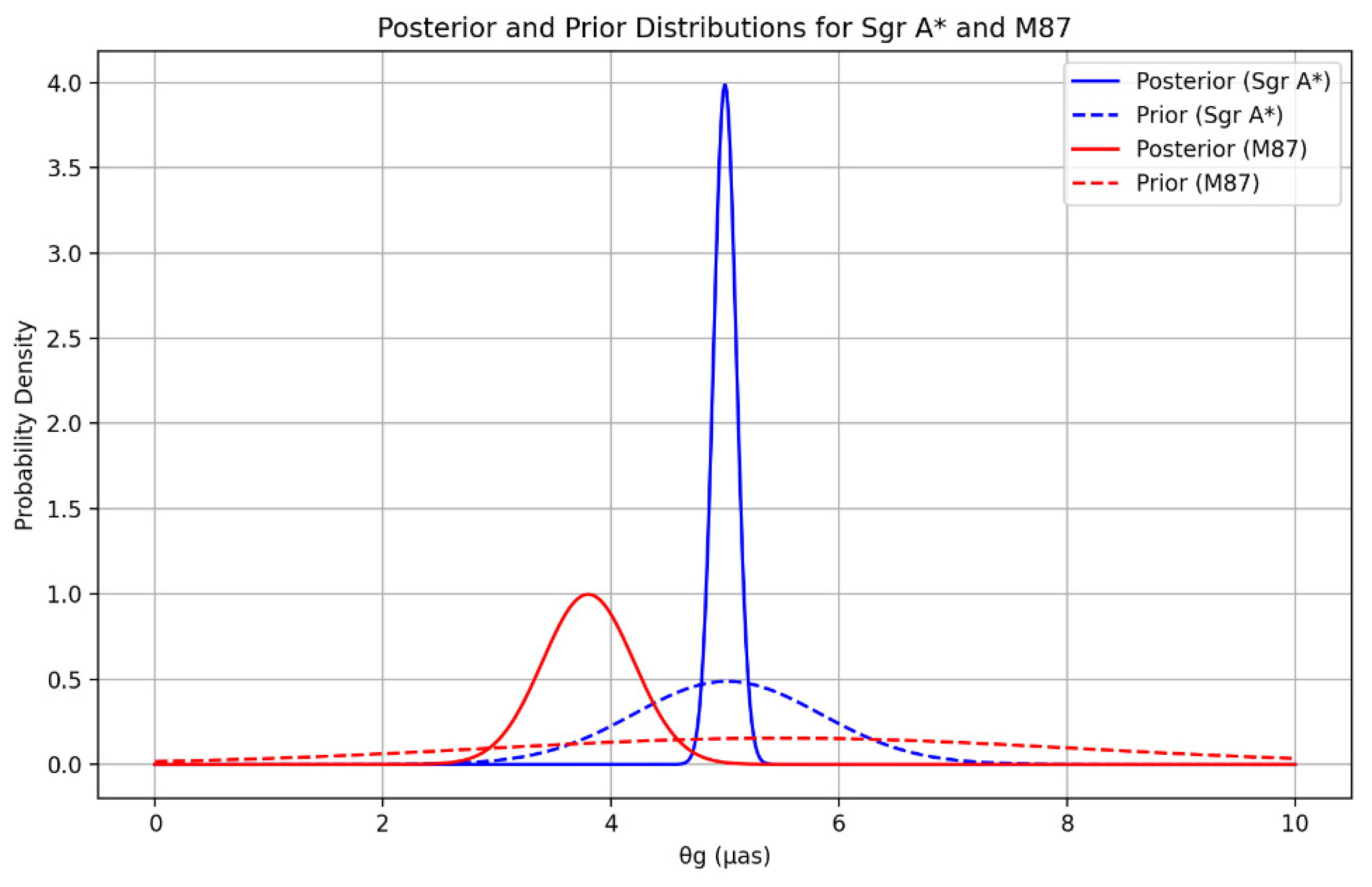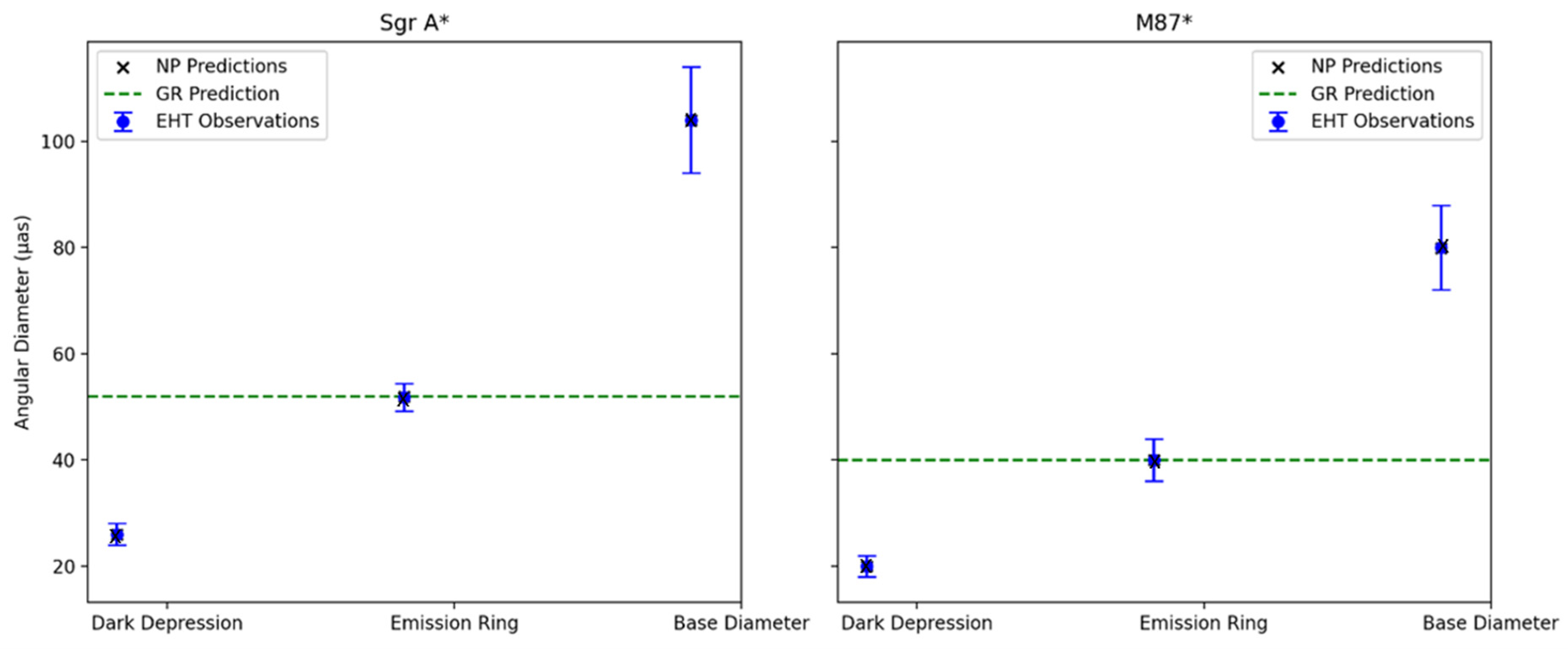1. Introduction
Black holes (BHs) provide a unique laboratory for testing theories of gravity in the strong-field regime, where quantum effects may become observable. The Event Horizon Telescope (EHT), using Very Long Baseline Interferometry (VLBI), has produced horizon-scale images of the supermassive black holes (SMBHs) Sgr A* and M87*, revealing features such as a central dark depression, a bright emission ring, and a base diameter [
1,
2,
3,
4,
5,
6,
7,
8,
9,
10,
11]. These observations, with angular resolutions as fine as 19 µas, offer a unique opportunity to test General Relativity (GR) against alternative gravity models, exotic compact objects (e.g., wormholes, naked singularities), and quantum gravity frameworks. The current literature uses EHT data to analyze shadow size, shape, and emission properties, constraining deviations from GR. It often combines this with General Relativistic Magnetohydrodynamics (GRMHD) simulations to model accretion flows.
In this work, we re-examine the work by Marongwe [
12] in which the Nexus Paradigm (NP), a lattice gauge theory of quantum gravity in Clifford space, which models space-time as a quantized crystal with
eigenstates [
12,
13,
14] claims a “99th percentile confidence interval” agreement with EHT data, but lacks detailed statistical analysis. The NP predicts distinct BH properties, including a halved Schwarzschild radius
and quantized orbital speeds
leading to specific angular diameters for SMBH features.
This paper conducts a Bayesian statistical analysis to rigorously test NP predictions against EHT observations for Sgr A* and M87*. We compute the posterior distribution for the angular scale parameter , assess goodness of fit using the statistic, and compare NP to GR. Our results quantify the NP’s consistency with observations in terms of sigma confidence levels, validating its claims and highlighting its advantages over GR.
The paper is organized as follows. In
Section 1 we discuss the methodologies for testing gravity theories using the EHT observations. This section allows a broad understanding of testing gravity using EHT observations. We examine key studies in this regard, taking into consideration their focus, findings, and significance. We then investigate their limitations and challenges as well as future directions.
Section 2 provides an overview of the fundamental physics of the Nexus Paradigm (NP), both in its semi-classical form and fully canonically quantized version.
Section 3 outlines the key predictions of NP.
Section 4 examines observational data from the Event Horizon Telescope (EHT). In
Section 5, we present our Bayesian analysis, and in
Section 6, we report the results, offer concluding remarks, and suggest directions for future work.
1.1. Methodologies for Testing Gravity Theories
The primary methodology in the current literature involves comparing the observed black hole shadow size and shape with theoretical predictions from GR and alternative models. The shadow size is determined by the photon sphere, which depends on the space-time metric, making it a sensitive probe for deviations from the Schwarzschild or Kerr solutions. Key approaches include:
Shadow Size Measurements: In which studies use the angular diameter of the shadow, calibrated by the mass-to-distance ratio of the black hole, to test theoretical models.
Parameterized Metrics: These are used to test deviations from GR. These include the Rezzolla-Zhidenko framework [
15] or the parameterized Schwarzschild metric (PSM) proposed by Tian and Zhu [
16]. These metrics introduce free parameters to model deviations from GR, which are then constrained by EHT data.
General Relativistic Magnetohydrodynamics (GRMHD) Simulations: Since in GR the shadow is surrounded by emission from accreting matter, GRMHD simulations are used to model the observed ring and distinguish between gravitational and astrophysical effects [
6,
7,
8,
9,
10,
17].
Alternative Gravity Models and Exotic Objects: Here, studies test specific alternative theories (e.g., Einstein-Æther, quadratic gravity, mimetic gravity) and compact objects like wormholes or naked singularities by computing their shadow properties and comparing them to EHT observations [
17,
18].
1.2. Key Studies and Findings
The literature spans a range of gravity theories and compact objects, with EHT observations providing stringent constraints. In this section we summarise some pivotal studies. We examine their focus, findings, and significance. One of the highly cited studies in this regard is the work by Vagnozzi et al. [
17]. This work focuses on a comprehensive study to test a broad array of deviations from GR using the EHT image of Sgr A*. It examines regular black holes (e.g., Bardeen, Hayward [
19,
20]), string-inspired space-times, violations of the no-hair theorem, and alternative gravity theories like beyond Horndeski models. It also tests black hole mimickers, such as the Damour-Solodukhin wormhole and naked singularities, using the shadow size and mass-to-distance ratio. The work finds that models predicting a shadow size larger than that of a Schwarzschild black hole are strongly constrained, with some constraints surpassing cosmological limits. However, certain mimickers, like wormholes, remain viable. A critique by Tsukamoto [
21] notes that the Damour-Solodukhin wormhole’s mass includes contributions from the parameter λ, challenging the study’s assumption of λ = 0. The significance of this study lies in that it highlights the power of EHT to probe a wide range of theoretical models, though its assumptions about mass parameters require careful consideration.
Another pivotal study is by Khodadi et al. [
18] which focuses on testing mimetic gravity, a modified theory related to GR via a non-invertible disformal transformation, using EHT images of M87* and Sgr A*. It examines naked singularities and black holes formed by non-trivial gluing procedures, computing their shadow properties. Khodadi et al. find that baseline mimetic gravity solutions (naked singularities and glued black holes) are inconsistent with EHT data, ruling them out. However, stealth Schwarzschild solutions with a trivial mimetic parameter (λ = 0) are allowed but cosmologically uninteresting. The study calls for exploring extensions of mimetic gravity. The importance of this work resides in that it demonstrates the complementarity of black hole imaging and cosmological tests in constraining modified gravity theories.
Marongwe [
12] focuses on testing the Nexus Paradigm, a quantum gravity model, against EHT images of Sgr A* and M87*. It compares the predicted angular diameter of the emission ring, central dark depression, and shadow base diameter with EHT data. The work finds that the Nexus Paradigm shows excellent agreement with EHT observations at the 99th percentile credibility interval, supporting its validity in the strong-field regime. More importantly, the work provides evidence for a quantum gravity framework. Unlike many theories that focus on general shadow size, the NP provides precise angular diameter predictions for the dark depression, emission ring, and base diameter, allowing for a more granular and unique comparison with EHT data.
J.Dass et al. [
22] test Quadratic Gravity using the EHT observations. Quadratic Gravity is a perturbatively renormalizable quantum gravity theory. It constructs a phase space of static, spherically symmetric space-times, including horizonless objects and wormholes, and analyzes shadow size deviations from Schwarzschild predictions. It was found that Quadratic gravity solutions align with GR outside the photon sphere but deviate near the center. EHT data constrains these deviations, particularly through brightness within the shadow region. These findings highlight the sensitivity of shadow brightness to non-GR effects, offering a new avenue for testing quantum gravity.
Tian and Zhu [
16] propose a Parametrized Schwarzschild Metric where the event horizon is located at
, with
n as a free parameter to test GR deviations. It uses M87* EHT data to explore whether the event horizon’s position differs from
. They find that a value of n ≈ 2 could explain discrepancies in black hole mass measurements, suggesting possible deviations from GR in strong fields. Their work offers a simple framework for testing GR but requires further validation with Sgr A* data.
Khodadi et al. [
23] test Einstein-Æther gravity, which allows Lorentz symmetry breaking, using M87* EHT data. It calculates the photon sphere radius and shadow size for two classes of black hole solutions. They find that the shadow size is sensitive to æther parameters, and EHT data constrains these parameters, providing insights into Lorentz-violating theories. Their work demonstrates EHT’s ability to test theories beyond GR that affect space-time symmetries.
1.3. Synthesis of Findings
The literature collectively demonstrates that EHT observations are a powerful tool for testing gravity theories, particularly in the strong-field regime where GR predictions are most robust. The literature shows that models like baseline mimetic gravity and certain quadratic gravity solutions are ruled out or heavily constrained, while others, like the Nexus Paradigm, show promise. Exotic Objects that mimic black holes such as wormholes, remain viable in some cases but face challenges due to mass parameter dependencies. Findings from the literature also show that the shadow size and brightness are sensitive to space-time geometry, but astrophysical effects (e.g., accretion) must be modeled carefully to isolate gravitational signals. In synthesis, the application of a comprehensive Bayesian analysis to evaluate the NP’s consistency with observational data is a modern and robust methodological novelty in this specific theoretical testing scenario.
1.4. Limitations and Challenges
Several limitations emerge across the literature. These include Mass-to-Distance Assumptions where many studies assume the mass-to-distance ratio is independent of the gravity theory, which may not hold for alternative models. This can lead to over-constrained or invalid conclusions. Astrophysical Uncertainties also present their challenges. GRMHD simulations rely on assumptions about accretion flows, which can obscure gravitational effects. Another limitation is that while EHT’s resolution is groundbreaking, subtle deviations from GR may require higher resolution or shorter-wavelength observations (e.g., 690 GHz).
1.5. Future Directions
The literature points to several avenues for future research. These include analyzing time variability in EHT data that could probe accretion dynamics and further constrain gravity models. Including polarimetric EHT data can reveal magnetic field structures, providing additional constraints on non-GR space-times. Multi-Messenger Approaches which involve combining EHT data with gravitational wave observations (e.g., from LISA) could test gravity theories across different regimes. Finally, the next-generation EHT arrays or space-based VLBI could enhance sensitivity to subtle deviations from GR.
2. A Synthesis of the Nexus Paradigm and Its Application to Black Hole Physics
The Nexus Paradigm [
12,
13,
14] is a lattice gauge theory in Clifford space where space-time is represented as a space-time crystal with
eigenstates (see Ref. [
14] for the latest version). In the NP, locations in space-time are described using local coordinates rather than points in space. The local coordinates are displacement vectors
characterized as quantized wave packets of space-time and can be expressed as Fourier integrals.
where
Here
are the Dirac matrices,
is the Hubble radius,
=
are Bloch energy eigenstate functions. Here the 4-wave vectors are quantized as follows:
The wave packets of 4-space have a minimum 4-radius equivalent to the Planck 4-length and a maximum four-dimensional radius comparable to the Hubble 4-radius. The eigenstates emerge from the ratio of the Hubble four radius to the Planck four length. The Bloch functions in each eigenstate of space-time generate an infinite Bravais four lattice.
The wave packet is a compact Einstein manifold, or a trivial Ricci soliton of positive Ricci curvature of the form.
Interestingly, there are two types of solitons: vacuum state solitons in which with a De Sitter topology and those associated with baryonic matter having an anti-De Sitter topology with . The anti-De Sitter solitons are a family of concentric black hole-like spherical surfaces of radii with corresponding orbital speeds of . The innermost marginally stable circular orbit occurs at half the Schwarzschild radius, implying that in the Nexus Paradigm, the event horizon is half the size predicted by GR. This distinctive characteristic should be observable with the Event Horizon Telescope. In contrast, the De Sitter soliton adopts low-energy quantum states with an increasing radius, while the anti-De Sitter soliton adopts high-energy quantum states with an increasing radius.
In the semi-classical version of the theory, Einstein’s field equations are modified to the form.
The modified Einstein Field Equations (EFE) of Equation (5) are formulated in De Sitter space and satisfy Lovelock’s theorem.
The exact solution [
14] in the extreme weak field is
Here
is the value of the Hubble parameter as measured in the ground state of space-time. The metric for the vacuum state
, of the quantized space-time is of the form
The metric equation above describes curved worldlines in flat space-time. A notable feature of this metric is the absence of singularities. At high energies, characterized by microscopic scale wavelengths of the Nexus graviton and elevated values of , the worldline becomes straight and the local coordinates are highly compact or localized. This characteristic also indicates asymptotic freedom in quantum gravity, as gravity (worldline curvature) diminishes asymptotically at high values of . Consequently, at high energies, graviton-graviton interactions cease due to the lack of curvature. The worldline begins to deviate significantly from a rectilinear trajectory at low energies, where uncertainties in its location are considerable, and the associated graviton wavelengths are at macroscopic scales. In the ground state of space-time we notice that the metric signature of Equation (7) becomes negative and that the worldline is straight.
2.1. A Covariant Canonical Approach to Quantizing General Relativity and Entanglement Speed
In the fully quantized formulation, general relativity is mapped onto a quantum field theoretic framework by representing the space-time metric components in terms of Bloch-mode energy eigenfunctions, as follows:
This means that the metric (geometry of space-time), a foundational concept in GR, emerges as a composite object built from entangled Dirac spinor fields, rather than being a fundamental entity. The presence of Dirac spinors implies that spin structure (SU (2) symmetry) is built into space-time at the most basic level. This links the quantum properties of fermions to the topology and connectivity of space-time, offering a deeper origin for curvature and torsion. Thus geometry is quantum entanglement of spinorial modes.
From Equation (8), we can now express the Ricci flow for the vacuum equations as follows (note
)
The term on the right suggests a covariant and a contravariant derivative operating on the metric coefficient such that the Ricci flow when expressed in terms of the Bloch functions becomes
where
The derivative operators on the RHS are entangled, and the coupling/diffusion coefficient, is an areal speed which is the speed of entanglement with a numerical value of approximately 5.2 square parsecs per second.
The Ricci flow in the presence of baryonic matter is expressed as
where
Baryonic matter serves as a heat sink, while the vacuum state of space-time functions as a heat source. As a result, gravitational attraction can be described as a transfer of space-time analogous to the process by which heat moves from a source to a sink. A test particle comprised of baryonic matter (local excitations of Dirac matter fields) moves along with the space-time towards the gravitating mass.
2.2. Quantum Spatio-Temporal Dynamics
We apply Equation (12) to understand the behavior of space-time within the deep gravitational potential of a BH. In other words, we seek to find the quantum dynamical behavior of a reference frame in a gravitational field with reference to a stationary reference frame in the absence of a gravitational field. To this end, we start by reducing Equation (12) to the form
In which the metric coefficients are expressed as follows
Factoring out the Minkowski metric component allows Equation (14) to be recast in the following form after multiplying by
.
Here the vacuum potential energy in the
-th quantum state is
where
is the reduced Planck constant and
Here
is the graviton mass implying that the graviton is a virtual particle with a range equal to the Hubble 4-radius. Equation (16) is a four-dimensional Schrödinger equation. In the absence of baryonic matter, it is analogous to the wave equation for the propagation of electromagnetic waves in a conducting medium. This analogy suggests that gravity is attenuated by the conductance of space-time, with increased attenuation at higher frequencies and energies. Additionally, Equation (17) establishes connections between macroscopic and microscopic scales, as well as between classical and quantum domains. The D’Alembertian of Equation (16) is expressed in spherical coordinates as follows:
We proceed by applying the method of separation of variables to solve Equation (16) in spherical coordinates, beginning with the following ansatz for the function
gFor steady state conditions where
and
, this method yields the following:
where
and
are constants arising from the separation of variables.
The angular equations within the spherically symmetric confinement system admit the following solutions:
And
where
is restricted to the range
and the associated Legendre function is
. Here
is the
Legendre polynomial. The product of
and
is the spherical harmonic
where
for
and
for
. The spherical harmonic is orthonormal
The equation for
can be further simplified by substituting
in Equation (22) yielding
This equation describes a bound quantum of space-time or a local coordinate system in an energy state inside a potential and experiencing a “centrifugal potential” .
2.3. Stasis and Time Evolution
We now focus our attention on the time evolution of a black hole-like surface
. Since these are marginally stable orbits where the kinetic energy and the potential energy are in equilibrium, the total energy is
, allowing Equation (27) to be simplified to the form
This yields a static configuration in which temporal evolution is absent and baryonic matter remains in stasis. The lack of a well-defined time parameter in quantum gravity is widely recognized as one of the field’s most profound challenges [
24,
25,
26,
27,
28,
29]. In the Nexus Paradigm (NP), the problem of time is addressed by introducing an intrinsic instability at
which gives rise to a finite lifetime
at the black hole–like surface, as constrained by the energy-time uncertainty relation
This energy uncertainty induces a corresponding uncertainty in the radial position
effectively endowing the surface with a finite thickness, defined by the range
. At
, the black hole–like surface reaches its closest proximity to the adjacent lower-energy surface located at
. This spatial overlap enables quantum tunneling of baryonic matter between successive surfaces, allowing transitions to states of lower vacuum energy. It follows that the metric in Equation (7) describes the space-time structure within the finite thickness of a black hole–like surface, characterized by the quantum number
. This is a semi-classical Schwarzschild-like space-time and can be alternatively expressed as
At high energies, the Schwarzschild space is flat and the lifetime and range within a BH-like surface are short.
The quantized space is described by a series of concentric BH-like surfaces or AdS Ricci solitons of radius on which no time evolution occurs as described by Equation (28).
Having gained insights into stasis and time evolution, we can now further simplify Equation (28) by making the following additional substitutions
Since
on a BH-like surface, then (30) reduces to
The above expression implies
where
The substitutions reduce Equation (28) to the form
Thus as the constant term in brackets dominates or , which satisfies the solution . The second term is irregular as implying which implies as .
Similarly, in the reverse scenario, as the centrifugal potential term dominates which leads to . This condition leads to a solution . Since the second term is irregular as therefore this implies as .
2.4. Hydrogen-like Solutions
We aim to find a solution that meets both asymptotic behaviors. We consider the ansatz
. A solution of this form has been solved for the simple hydrogen atom. Taking hints from Equations (33) and (34), we propose that the solution to the radial equation of the quantum gravity system
is identical to the radial equation for the hydrogen atom. We test this proposition by comparing the expression in the quantized space for the BH-like surfaces
with that obtained from a radial function identical to that of the hydrogen atom. In this case, the radial probability distribution function is
where
and will peak at a value of
determined by
That is at
. This solution implies that
for the quantum gravity system characterized by an AdS Ricci soliton. Thus
is of the form
where
and
is the
Laguerre polynomial. Therefore the steady state quantum gravity system can be written as
where
In synthesis, the function
describes the quantum dynamical behavior of a local coordinate system
in a gravitational potential with reference to a stationary coordinate system
in flat space-time. From a quantum gravity perspective, the value of
is not definite but uncertain relative to a stationary reference frame. The most probable value being
as computed in Equation (36). The expectation value
is calculated from
The function
, describes the precession of
with reference to
with an uncertainty in the angle of nutation (See
Figure 1). This results in a fuzzy reference frame with uncertain Lorentz boosts, where only the expectation and most probable values can be calculated. It is also noted that for large distances or high energies, the wave function rapidly diminishes, indicating no discernible spatio-temporal dynamical behavior at high energies and large distances. This wobbling reference frame results in hollow conical or helicoidal astrophysical jets emerging from BHs. However, for De Sitter-type Ricci solitons, the spatio-temporal dynamical behavior should be observable at large radii and low energies. Undulations in the trajectories of stars at the edges of galaxies and the enigmatic galactic planes of satellites could serve as potential indicators.
3. Nexus Paradigm Predictions of the BH Environment
Having derived the equations governing the quantum dynamical behavior of a reference frame in a gravitational potential, we aim to predict the expected observations at horizon scales. It is essential to emphasize the key distinction between a black hole in Schwarzschild space and one in quantized space. A BH in quantized space will behave as a BH in Schwarzschild space but with half the mass.
Table 1 shows how this aspect changes some important quantities associated with BHs.
It is interesting to note that the photon sphere in quantized space is the expectation value of the ISCO of
in quantized space. That is
The innermost marginally bound orbital is computed from which for n = 2 yields . The expectation value for the orbital is computed as . The same value is obtained in GR through geometric computations; however, in quantum gravity, there are two sets of values. The other involves the p orbital ( which yields . Thus, in quantum gravity, the innermost stable circular orbit can be closer than for a Schwarzschild black hole in GR.
Ray Tracing
The ray tracing in quantized space follows the same procedure as in the Schwarzschild space as computed in the literature [
30,
31] but having half the value of the impact parameter. Since the rays emanate from the event horizon, the rays follow a path that magnifies the image of the BH by a factor of
such that the gravitationally lensed values for the orbits
and
will show as depicted in
Figure 2. A dark central depression of angular diameter
is to be expected. Thus for Sgr A*, we expect a value for the dark depression of
and for M87* a value of
.
6. Results
For SgrA*, we have EHT 2017 campaign observations for the three angular diameters for the key image features such as dark depression, emission ring, and base diameter
as with
as, we find best-fit
as, yielding predictions
as. Thus
With and reduced . This yields a confidence level for corresponding to 3.04 (99.73% confidence). Thus for the confidence per feature, we have for the dark depression a deviation of as corresponding to a to 0.02 deviation, for the emission ring a deviation of as corresponding to a to 0.06 deviation and finally for the base diameter a deviation of as corresponding to a to 0.008 deviation, Each feature agrees at >99% confidence (<1 ). We compute the posterior for as as. This corresponds to a 99% credible interval of [4.74, 5.26] as, encompassing the prior mean (5.02 as) within .
For M87*, we have for the EHT 2017 campaign observations of the three angular diameters for the key image features
as with
as, we find the best-fit
as, yielding predictions
as. Therefore
With
and reduced
. This yields a confidence level for
, corresponding to 2.88
(99.80% confidence). Thus for the confidence per feature, we have for the dark depression a deviation of
as corresponding to a to 0.015
deviation, for the emission ring, a deviation of
as corresponding to a to 0.015
deviation and finally for the base diameter, a deviation of
as corresponding to a to 0.015
deviation, Each feature agrees at >99.9% confidence (<1
). We compute the posterior for
as
as. This corresponds to a 99% credible interval of [3.47, 4.25]
as, within
of the prior mean of 3.85
as. The predictions of each feature by GR and NP are displayed in
Figure 7.
6.1. Combined Fit
The combined fit yields a , dof = 4, (6 data points and 2 parameters). This yields a confidence level for , corresponding to 4.37 (99.9972% confidence). The reduced , indicating an excellent fit.
6.2. GR Comparison
For the SgrA* dark depression
as, GR predicts
as. Thus
This deviation yields , corresponding to 12.97 indicating extreme inconsistency. The NP is favored at .
7. Discussion
The Bayesian analysis confirms the NP’s excellent agreement with EHT observations, with a combined fit at 4.37
(99.9972% confidence), exceeding the 99th percentile (~2.326
) claimed by Marongwe in [
12]. Individual features deviate by <0.1σ, supporting the NP’s predictions for the dark depression, emission ring, and base diameter. The posterior θg values align with prior expectations within ~0.2
, reinforcing consistency.
Compared to GR, which mispredicts the dark depression at ~12.97
, the NP’s ability to fit multiple features is a significant advantage. The Bayes factor
strongly favors NP, though GR aligns with the emission ring, suggesting plasma dynamics may complement GR’s shadow prediction [
36].
The NP’s quantized space-time, with a halved Schwarzschild radius and quantum tunneling for emission rings, offers a compelling alternative to GR, addressing observed stable orbits below the Innermost Stable Circular Orbit [
13]. Its predictions of hollow conical jets, confirmed in M87* and Centaurus A*, further support its astrophysical relevance [
37].
